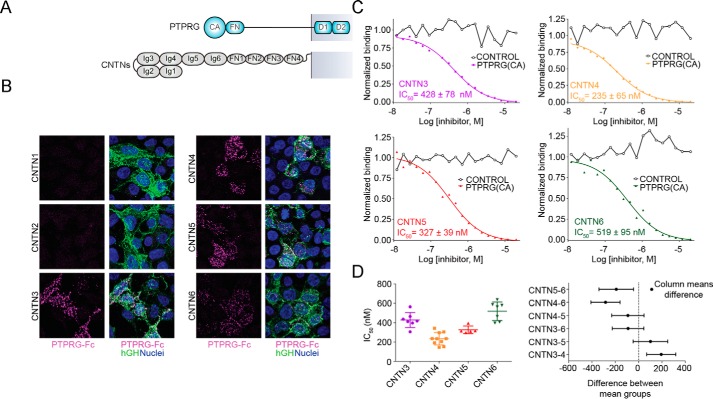FIGURE 1.
PTPRG interacts specifically with CNTN3, -4, -5, and -6. A, domain organization of PTPRG and CNTNs. PTPRG includes an inactive N-terminal CA domain, a single FN type III domain, a spacer region, and two intracellular tyrosine phosphatase domains. CNTNs include six Ig domains, four FN domains, and a GPI anchor. B, the extracellular domain of PTPRG associates with CNTN3–6 but not with CNTN1 or CNTN2. HEK293 cells transfected with full-length CNTNs fused to human growth hormone were incubated with an Fc fusion of the CA and FN domains of mouse PTPRG labeled with fluorescein iosothiocyanate (magenta). CNTN-expressing cells were labeled with an antibody conjugated to a green fluorophore. The nuclei were visualized using DAPI. C, interactions between the CA domain of PTPRG with CNTN3–6, as determined by an AlphaScreen bead-based competition assay. The ability of mouse PTPRG(CA) or bovine CAII (control) to inhibit binding between an Fc fusion of full-length mouse CNTN3–6 and biotin-labeled PTPRG(CA) was assessed over a logarithmic dilution series. IC50 values are reported as averages ± S.D. (error bars) from at least three experiments. One representative experiment for each series is shown. See supplemental Table S1 for detailed results. D, one-way ANOVA analysis of the IC50 values measured in C. The means and S.D. values are shown on the graph on the left, whereas the graph on the right shows Tukey 99% confidence intervals for Tukey's multiple comparison tests. Differences between CNTN3 and CNTN4, CNTN4 and CNTN6, and CNTN5 and CNTN6 are statistically significant, whereas the remaining IC50 differences (between CNTN3 and CNTN5, CNTN3 and CNTN6, and CNTN4 and CNTN5) are not. See supplemental Fig. S1.

